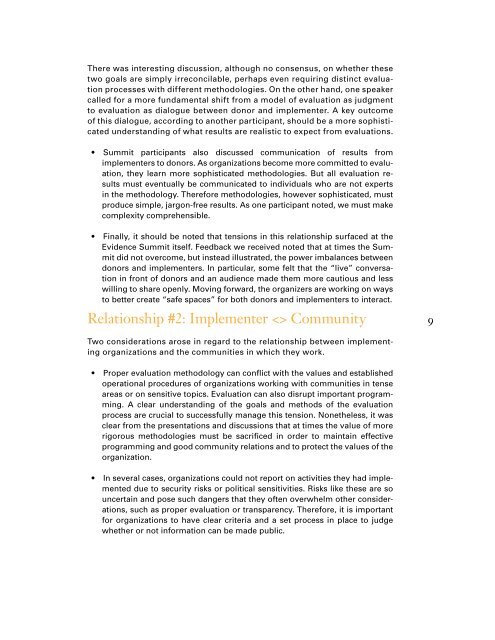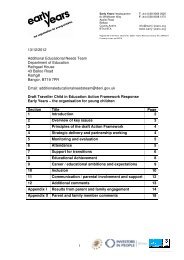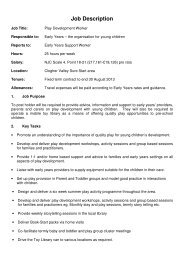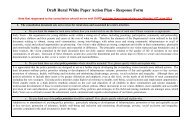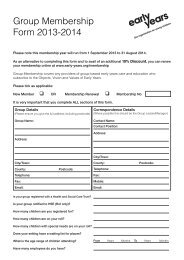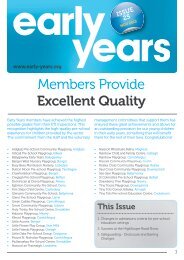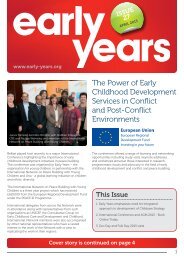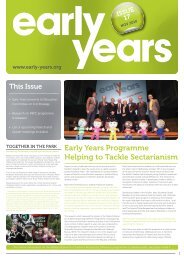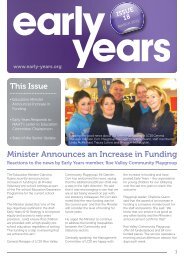Learning from Nine Examples of Peacebuilding Evaluation
Learning from Nine Examples of Peacebuilding Evaluation
Learning from Nine Examples of Peacebuilding Evaluation
You also want an ePaper? Increase the reach of your titles
YUMPU automatically turns print PDFs into web optimized ePapers that Google loves.
There was interesting discussion, although no consensus, on whether these<br />
two goals are simply irreconcilable, perhaps even requiring distinct evaluation<br />
processes with different methodologies. On the other hand, one speaker<br />
called for a more fundamental shift <strong>from</strong> a model <strong>of</strong> evaluation as judgment<br />
to evaluation as dialogue between donor and implementer. A key outcome<br />
<strong>of</strong> this dialogue, according to another participant, should be a more sophisticated<br />
understanding <strong>of</strong> what results are realistic to expect <strong>from</strong> evaluations.<br />
• Summit participants also discussed communication <strong>of</strong> results <strong>from</strong><br />
implementers to donors. As organizations become more committed to evaluation,<br />
they learn more sophisticated methodologies. But all evaluation results<br />
must eventually be communicated to individuals who are not experts<br />
in the methodology. Therefore methodologies, however sophisticated, must<br />
produce simple, jargon-free results. As one participant noted, we must make<br />
complexity comprehensible.<br />
• Finally, it should be noted that tensions in this relationship surfaced at the<br />
Evidence Summit itself. Feedback we received noted that at times the Summit<br />
did not overcome, but instead illustrated, the power imbalances between<br />
donors and implementers. In particular, some felt that the “live” conversation<br />
in front <strong>of</strong> donors and an audience made them more cautious and less<br />
willing to share openly. Moving forward, the organizers are working on ways<br />
to better create “safe spaces” for both donors and implementers to interact.<br />
Relationship #2: Implementer Community<br />
9<br />
Two considerations arose in regard to the relationship between implementing<br />
organizations and the communities in which they work.<br />
• Proper evaluation methodology can conflict with the values and established<br />
operational procedures <strong>of</strong> organizations working with communities in tense<br />
areas or on sensitive topics. <strong>Evaluation</strong> can also disrupt important programming.<br />
A clear understanding <strong>of</strong> the goals and methods <strong>of</strong> the evaluation<br />
process are crucial to successfully manage this tension. Nonetheless, it was<br />
clear <strong>from</strong> the presentations and discussions that at times the value <strong>of</strong> more<br />
rigorous methodologies must be sacrificed in order to maintain effective<br />
programming and good community relations and to protect the values <strong>of</strong> the<br />
organization.<br />
• In several cases, organizations could not report on activities they had implemented<br />
due to security risks or political sensitivities. Risks like these are so<br />
uncertain and pose such dangers that they <strong>of</strong>ten overwhelm other considerations,<br />
such as proper evaluation or transparency. Therefore, it is important<br />
for organizations to have clear criteria and a set process in place to judge<br />
whether or not information can be made public.


